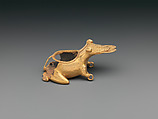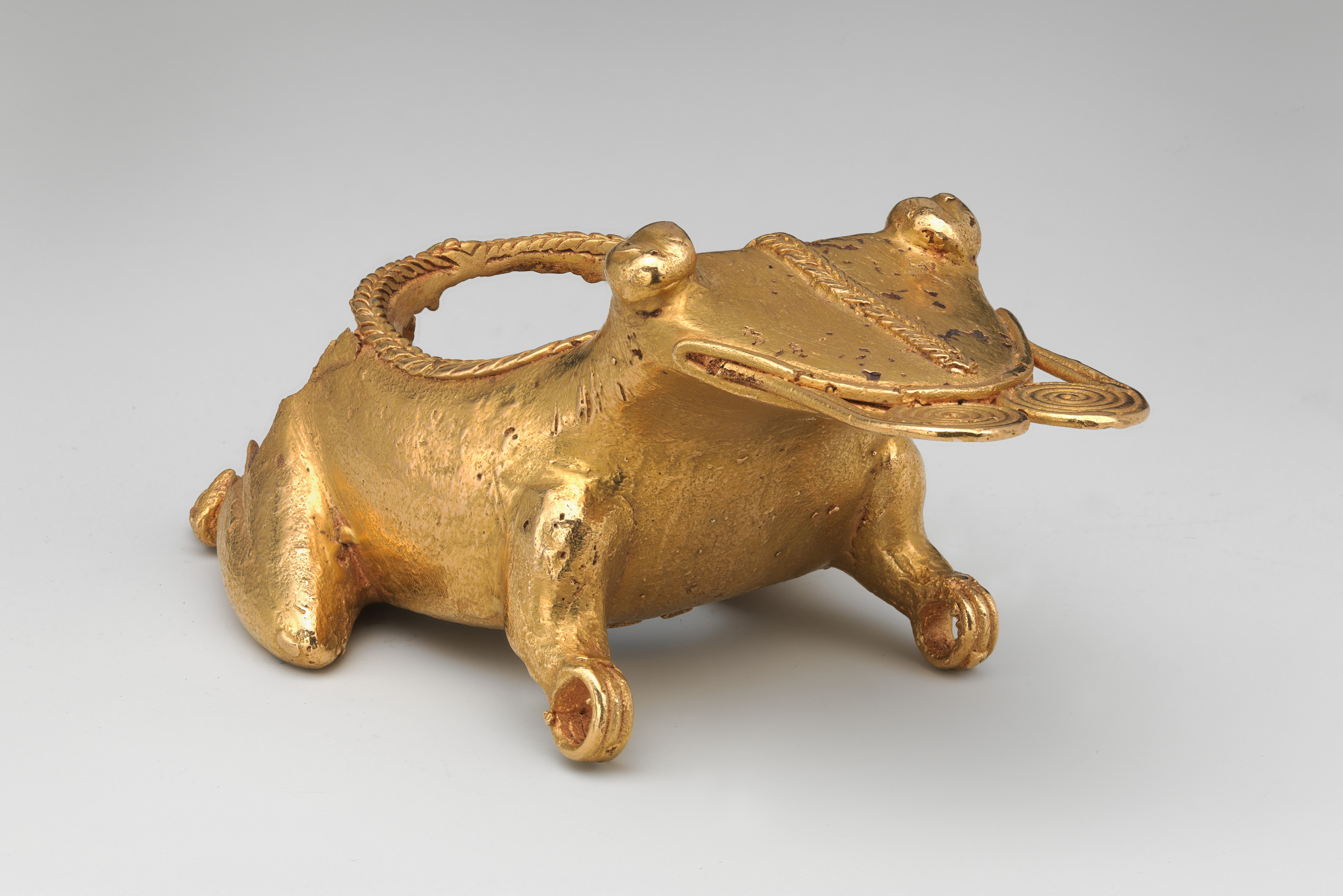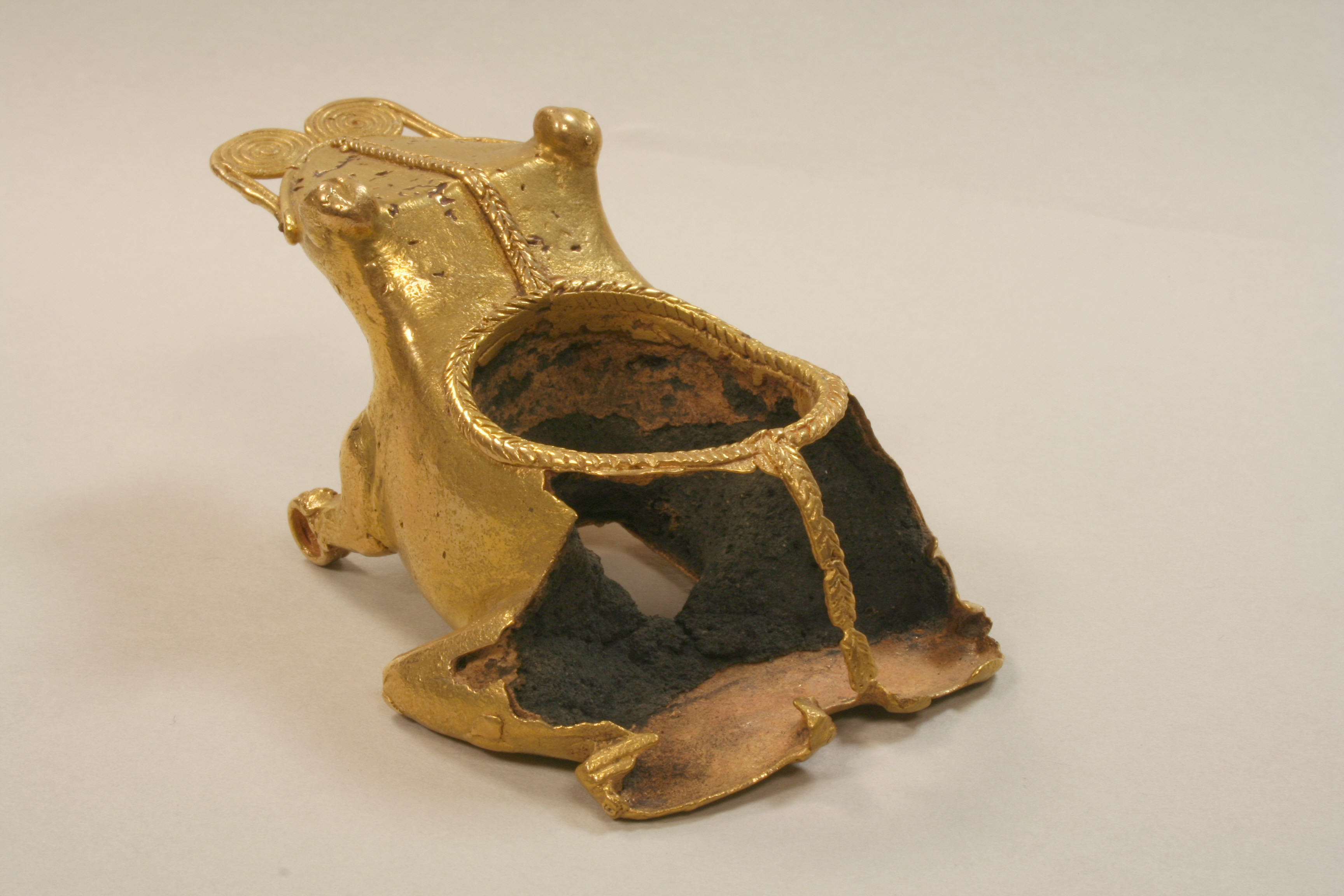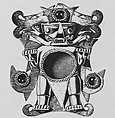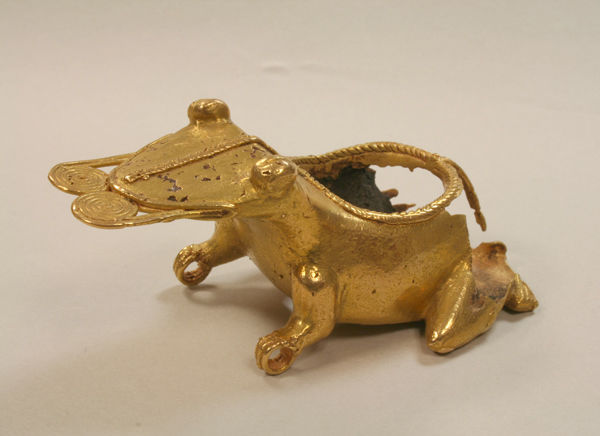Frog Pendant
Not on view
This pendant, in the form of a frog, is suggestive of a range of frog species in the area where it was likely fabricated (see image 1). It is made of cast metal, likely an alloy of gold with copper. Its carbonized ceramic core is partially preserved. The frog looks forward. Its spherical eyes are at the top corners of its head, and they have linear indentations in their centers. The frog’s tongue projects outward, illustrated as two spirals that are connected to the center of the mouth and at its ends by a thick, curved band of metal (see image 2). There is a plain band of metal that outlines the mouth. Another band has a chevron design, and it extends from the mouth down the center of the head and then connects with another chevron band forming a circle on the back of the frog (see image 3). The internal diameter of this circular band is 3.1 cm. The chevron band along the central axis resumes at the rear of the frog, where it emerges out of the circular band on top. The front legs project forward and, instead of naturalistic feet at their ends, they have circular suspension loops. The hind legs are bent and angled toward the ground with the hind feet projecting outward.
All of these details would have been designed originally in wax. The chevron band has the appearance of filigree but the artists created this design by plaiting two threads of wax. They formed the entire wax model around a core that was likely a combination of clay and charcoal. During the casting process, the frog’s interior would have been mostly filled with this core material. Artists covered the wax model with ceramic investment, and melted out the wax to create a mold. This mold was then possibly pre-heated, and molten metal was poured into the space formerly occupied by the wax. Once the metal solidified, the artists broke open the hardened ceramic investment to release the cast object. Portions of the original core are still preserved in this example.
It is possible that the core was exposed at the back of the frog, in the area of the circular band, throughout this process. An inlay may have been added after the casting, but no inlay has preserved. There is little space between the top of the core material (based indirectly on the appearance of encrustations of core material on the interior walls) and the top of the circular chevron band, so the inlay was likely very thin, or else it projected out of the top.
Between the possible use of pre-heating before the molten metal was poured into the mold (with the core still present) and the pour of the metal, a reducing atmosphere was created in the core, heating it and giving it the appearance that is visible today. The sandy, coastal environment of the area where it was deposited also has affected the appearance of the core. There appear to be two large metal regions missing at the rear of the frog, on either side of the vertical chevron band. These missing components include parts of each hind foot. On the frog’s underside, there is a large rectangular opening (2.4 x 1.6 cm) in the area of the abdomen. This opening was likely carved into the wax model rather than into the metal after casting. On a range of cast metal pendants from the Isthmian region (e.g., Fernández 2004, pl. IX), there are openings that artists may have intentionally designed so that core material could be removed after casting. But, in this case, assuming the top of the frog was open during the casting process, core material very easily could have been removed from the top. Considering that the core is partially intact, the role of this rectangular opening in the casting, or even in the decorative design, is uncertain.
This object was recovered from the northwest corner of Grave 10 at Playa Venado (occasionally discussed as “Venado Beach”) in the Panamanian Canal Zone (Cooke et al., under review). The excavations of the site only took place after the US Navy, employing bulldozers, removed topsoil from this area in 1948 to use for their lawns and flower gardens. In the process, they came across a cemetery, which was excavated over time by a local society of archaeologists, including Neville and Eva Harte, and Lt. Col. Lee Montgomery, and then by the Peabody Museum at Harvard, primarily under Samuel Lothrop. [1]
Grave 10 was excavated under Montgomery on August 12, 1951. According to his excavation records, he found this object, 1979.206.1350, within an urn that also contained human remains (apparently related to one person), “white beads,” an incense burner (which he describes on another page as a “fine small pot” and in an illustration on this other page as a “small incised poison pot”), and a gold plate (approximately 13 cm in diameter). The urn apparently was located under 2 feet of black soil and 5 feet of red clay, and within a stratum of yellow clay that was 5 feet high. (Please see Doyle 2015 for more details about the excavations and itineraries of the materials recovered.)
The ceramics from across the cemetery at Playa Venado by and large belong, within the wider Greater Coclé ceramic sequence, to the Cubitá and Early Conte styles, dating from A.D. 550 to A.D. 850 (calibrated) (Cooke 2004, 274). Four other metal frogs were found associated with human burials during the Montgomery excavations. One “large gold frog,” weighing 60.3 g, was associated with the forehead of one individual, also buried in Grave 10, but separate from the urn burial. In Grave 9, Montgomery also found an individual buried with a gold frog, weighing 47 g, on their forehead. This frog pendant, fabricated by lost-wax casting but with a false filigree design, is Metropolitan Museum of Art 1979.206.1351. A range of other artifacts, especially in metal, shell, and bone, associated with the Playa Venado excavations have been sent on different trajectories, with some at the Metropolitan Museum of Art (besides the present object and 1979.206.1351, 1978.412.52, 1979.206.1352, 1979.206.1353), Dumbarton Oaks (PC.B.372, PC.B.382, PC.B.387, PC.B.388, PC.B.389, PC.B.390, PC.B.391, PC.B.392), the Art Institute of Chicago (1969.792, 1969.793, 1969.794, 1969.795, 1971.774), and the National Museum of the American Indian (22/5838, 22/5840, 22/5842, 23/01051, 23/0152, 23/0153, 23/0154, 23/0155, 23/4837, 24/0633, 24/0634, 24/0650, 24/0661, 24/0688).
As noted, parts of the hind feet of the frog are missing. However, what remains of the proper left hind foot is suggestive of a design that it seen on other Coclé representations of frogs. The feet likely had a ridged appearance, comprised of a handful of raised stripes, probably formed by pressing thin threads of wax onto each pre-existing foot while the model was being made. Such designs are seen on a frog pendant from El Indio (Cooke et al. 2000, fig. 8.2c) and El Caño (Cooke et al. 2000, fig. 8.1h). In the latter case, the feet appear to have been originally composed of these wax threads, rather than made by adding one layer of wax on top of another.
Also, the circular chevron band on the present example likely surrounded an inlay at one time. There is little space between the top of the core material (based indirectly on the appearance of encrustations of core material on the interior walls) and the top of the circular chevron band, so the inlay was likely very thin if it was flush with the top of the metal, or else it projected from the top. Other metal figurines have preserved inlay, including a Greater Chiriquí pendant, Metropolitan Museum of Art 1979.206.1064, whose pyrite inlay is round but projects above the surface of the metal. A “mirror frame” is described by Lothrop (1937, 104–105) from Sitio Conte, associated with a person buried in Grave 5 (see image 4). Made of cast metal, it depicts a figure with bat and crocodilian features. There is a large circular opening in its torso bordered by a chevron band very similar to that of the present example. No inlay has survived but Lothrop suggests that some sort of inlay, perhaps pyrite, once occupied this space and owing to the reflective qualities of that mineral, acted as a mirror. There are three other circular chevron bands, smaller than the torso’s, that appear on this pendant, forming the borders of openings, but with no inlay preserved; two perforations, which may have been used to attach the inlay, as Lothrop suggests, are visible in the area of metal on the reverse of these three circular regions.
Whether this frog pendant also had the qualities of a mirror owing to a once-present inlay, it is important to consider that it was buried with human remains and other artifacts within an urn, creating a set of relations that was different from the those involving the two human burials that were adjacent in Grave 10, one of which also included a gold frog. The limited contextual information from the Montgomery notes leaves many questions unanswered. How did the placement of objects matter to the people who buried this person? What was the positioning of the frog pendant was within the urn? Was this person buried with the frog pendant on their forehead similar to what appears to be the case in a nearby burial? While it may be a great challenge to answer any of these questions, it is vital to recognize the associations of people with materials and how those associations have been disrupted and dispersed over time.
Bryan Cockrell, Curatorial Fellow, Arts of Africa, Oceania, and the Americas, 2017
[1] The presence of the US military in this area and the US control of the Canal Zone was highly contentious. Around the time of the Harte and Montgomery excavations and Lothrop’s (1956) publication of those projects, Panamanians sought to raise the Panamanian flag in the Canal Zone on several occasions, facing repression by US troops and at times the Panamanian National Guard (Aguirre 2010).
Exhibition History
Leningrad, Hermitage Museum, Gold of Precolumbian America, Aug. 4 – Oct. 1, 1976; Moscow, The State Museum of Representational Arts, Oct. 15 – Dec. 15, 1976; The Kiev State Historical Museum, Jan. 5 – Mar. 1, 1977, p. 139, cat. no. 123, ill.
References>
Aguirre, Robert W. 2010. The Panama Canal. Leiden: Martinus Nijhoff Publishers.
Cooke, Richard. “Rich, Poor, Shaman, Child: Animals, Rank, and Status in the ‘Gran Coclé’ Culture Area of Pre-Columbian Panama.” In Behaviour Behind Bones: The Zooarchaeology of Ritual, Religion, Status and Identity, edited by Sharyn Jones O’Day, Wim Van Neer, and Anton Ervynck, 271-284. Oxford: Oxbow Books, 2004.
Cooke, Richard, Warwick Bray, Luís Sánchez, Nicole Smith-Guzmán, Máximo Jimenez. “Playa Venado.” In The Art of Central America and Colombia, edited by Colin McEwan, Bryan Cockrell, and John Hoopes. Washington, D.C.: Dumbarton Oaks Research Library and Collection, under review.
Cooke, Richard, Luís Alberto Sánchez Herrera, and Koichi Udagawa. “Contextualized Goldwork from ‘Gran Coclé,’ Panama.” In Precolumbian Gold: Technology, Style and Iconography, edited by Colin McEwan, 154-176. London: British Museum, 2000.
Doyle, James. “Unearthing Gold Masterpieces from Venado Beach, Panama.” Now at the Met. Last modified August 28, 2015, http://metmuseum.org/blogs/now-at-the-met/2015/unearthing-gold-masterpieces
Fernández Esquivel, Patricia. Museo del Oro Precolombino de Costa Rica. San José: Fundación Museos Banco Central de Costa Rica, 2004.
Lothrop, Samuel K. “Jewelry from the Panama Canal Zone.” Archaeology 9, no.1 (1956): 34-40.
Due to rights restrictions, this image cannot be enlarged, viewed at full screen, or downloaded.
This artwork is meant to be viewed from right to left. Scroll left to view more.
